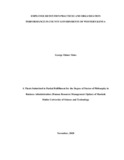EMPLOYEE RETENTION PRACTICESAND ORGANIZATION PERFORMANCE IN COUNTY GOVERNMENTS OF WESTERNKENYA
Abstract
In order for organizations to compete favorablyin thecurrent global economy, they need to invest heavily in employee retention practices. Former Western ProvinceCountiesin Kenya have been experiencing acute employees shortagedue to their inability to attract and retain qualified personnel. This has resultedto poor county governmentperformance resulting to; delaysin projects initiation and completion, missingrevenue collection targets, and poor service delivery to the citizens. Embracing employee retention practicescoupled with good county leadershipcan act as asolutionto the county dismal performance. The main objective of the study was therefore to investigate theeffect of employee retentionpracticesand county leadershipon organization performance in county governments of Former Western Province, Kenya.The specific objectives of the study were to determined the effect of;competitivecompensation, competency training, career growth and development, and work-life balance on organization performance in county governments of Former Western Province. It alsoinvestigatedthe moderating effect of county leadership on the relationship between employee retention practicesand organization performance in county governments of Former Western Province.The study was anchored on fivetheories namely:resource based view theory; Equity theory of motivation; Social cognitive learning theory;Socialcognitive career theory; and Spill over and work boarder theories. The study was premised on positivism paradigm philosophy. Mixed research design involving cross-sectional survey and descriptive correlational research designswere adoptedin the study. 1, 826 employees were targeted out of which 328 respondents weresampled.Stratified sampling and simple random sampling techniques wereemployed to enable the researcher to select the respondents of the study in Kakamega, Vihiga, Busia and Bungoma Counties. Pilot study was conducted in Siaya County. The study collectedprimary data by use of questionnaires and interview schedule. Validity and reliability of research instruments were assured.The resultant Cronbach’s Alpha value was0.923 thus above the 0.7 acceptablethreshold in social research. The data collected wasanalyzed using descriptive and inferential statistics. Inferential statisticinvolved the use of Pearson Product Moment correlation coefficient and regression models while descriptive statistic involved the use of percentage, mean and standard deviation. Data waspresented by use offrequency distribution tables and figures.The study found out thatemployee retention practices of; work-life balance, competency training, competitive compensation and career growth and development contributes to 16.8%, 13.6%, 11.7% and 10.7% respectively of the variability on organization performance. Employee retention practicesalso had a significant positive effect on organizationperformancein county governments of Former Western Province. The study noted that county leadership moderatedthe relationship between employee retention practices and organization performance in county governments of Former Western Provinceat a rate of 52.9%. It was therefore recommended that county governments should formulate, develop and implement employee retention practices entailing; work-life balance, competency training, competitive compensation and career growth and development so as to realize improved organization performance. Government and organization policy makers may utilizethe study findings in developinghuman resource policies on employeeretention practices for betterorganization performance while academia and other researchersmayrely on the study rich empirical literaturetofurtherresearchin the study area.

